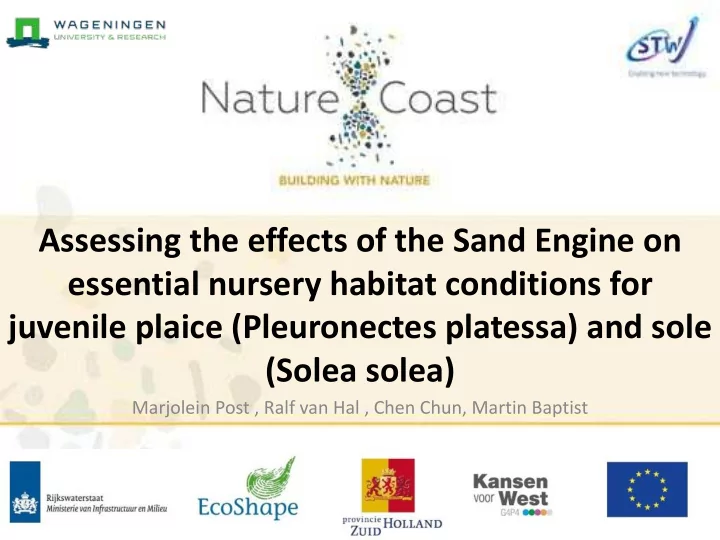

Assessing the effects of the Sand Engine on essential nursery habitat conditions for juvenile plaice (Pleuronectes platessa) and sole (Solea solea) Marjolein Post , Ralf van Hal , Chen Chun, Martin Baptist
Introduction • Coastal sea is an important flatfish nursery • Increase in sand nourishments • Direct effect on nursery habitat
Sand nourishment strategies • Placing sand on the beach • Sediment supply at 5-8m depth • Concentrated mega- nourishment
Sand Engine: mega-nourishment Dutch coastline How does this affect important habitat conditions for juvenile flatfish? Sand Engine • 21.5 million m 3 sand • 1.5 km wide • 2 km long
Fish in a Sand-box
Sampling design SOUTH SAND ENGINE NORTH 2012 2013 2015
Methods • 0-group plaice and sole • Fish sampling season 2012: August/September 2013: October 2015: October • Selected prey species based on diet studies • Percentage of medium sand (250-500µm) • Depth • Statistics – Zero inflated glmm’s
Sediment grain size Aimed grain size nourished sand Figure 3. Changes in median grain size in 2012 (a), 2013 (b) and 2015 (c). Maps were made by kriging in ArcGis.
Benthic prey
Fish abundance • Annual difference in numbers – Substantially higher catch in 2012 638 plaice in 2012, 248 (2013) and 331 (2015) 790 sole in 2012, 138 (2013) and 132 (2015) • Variation in distribution – Generally the highest numbers around the Sand Engine – Seemingly associated with prey abundance
Analysis - Sole • Annual and spatial variability • Positive association with benthic abundance
Analysis - Plaice • Annual and spatial variability • Increased abundance with higher prey biomass • Negative relation with medium sand
Discussion • Sediment coarsening – Resulting in decreased abundance of plaice • Local variability in prey biomass – Initial benefit for opportunistic species – Related to plaice and sole abundance – Indication of community recovery after 4 years • Lack of seasonal data – Baseline is necessary
• Sediment grain size – Grain size of the Dutch coast went from 210 µm to 320 µm • Seasonal timing of nourishment – Allow for recovery with a nourishment in winter Theoretical modelling
Any questions? marjolein.post@wur.nl
Recommend
More recommend